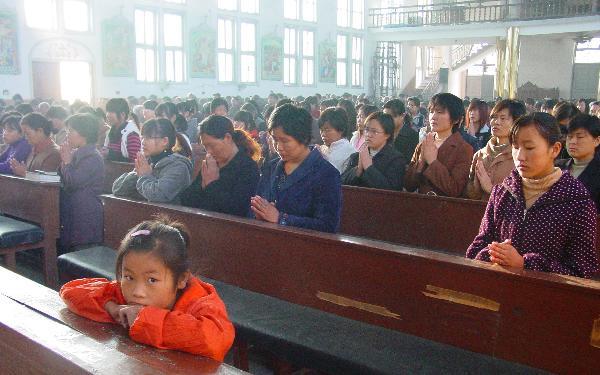As the world’s spotlights focus on China in the weeks preceding the 2008 Olympic Games, the growth of the Catholic Church in the country remains behind the scenes. John Pontifex reflects on his recent visit, and explores how the Church in China’s Jesuit origins can help the country’s faithful find a balance between their religious faith and cultural identity.
It will take more than an uprising in Tibet and an earthquake in a central province to derail China’s determination to make the Olympics a showcase of the best the country has to offer.
From the moment the opening ceremony gets under way in August, every detail of the games will be a dazzling spectacle intended to mesmerise economists, politicians and even sceptical journalists.
The over-arching theme of this world-beating PR exercise will be, no doubt, to celebrate a new-found confidence in the Chinese culture and way of life, even in the face of globalisation.
Travelling through China as I did last autumn with Aid to the Church in Need, the charity for suffering Christians, I was struck by how a profound nationalism, as old as China’s history, not only had survived but had reinvented itself to become a phenomenon inextricably linked with the country’s spectacular economic growth.
The struggle to keep China free of ‘foreign influences’ inevitably keeps alive the long-standing institutionalised suspicion towards religion as a whole, Christianity in general, and Catholicism in particular.
But to what extent is Christianity in China perceived as ‘foreign’ and to what extent does this represent an insuperable challenge to the Church’s growth? One of the facts the authorities will definitely not show-case at the Olympics is the growth of Christianity to the tune of up to 100,000 converts to Catholicism every year.
An increasingly educated society, quizzical about the cultural and intellectual backdrop to Christianity, is no doubt quickly discovering that Catholicism is not quite so foreign to China as they had been led to believe. And perhaps this explains to some extent why Christianity is spreading further and deeper than the authorities would prefer to admit.
Any understanding of China’s surprisingly ancient Christian heritage inevitably draws the student of Church history in the region to the remarkable role played by the Jesuits.
The astonishing figure of Fr Matteo Ricci is in many respects the most memorable of all missionaries in the period running up to the 19th century when Christianity spread under the protection of Western imperial advances into China.
Ricci’s distinctive missionary style, supremely receptive to Chinese culture and language, paved the way for Christianity’s acceptance in the halls of imperial Chinese power. Of course, Ricci was not the first Jesuit to have missionary designs on China. Francis Xavier, the protégé of Ignatius Loyola himself, turned his attentions to China having worked tirelessly in other parts of Asia for many years. Finally in the early 1550s, Francis Xavier landed on Shangchuan (Sancian), an island of the southern coast of Guangdong Province. He waited for an opportunity to sail to the mainland but died within a year. The year of his death coincided with the birth of Matteo Ricci.
Soon after arriving in China in 1582, Ricci began learning the Chinese language and customs. Moving inland from Macau, near Hong Kong, to Canton and then onto Guangdong Province, Ricci soon became proficient in classical Chinese. Becoming expert in Confucian thought, which he translated into Latin, he identified himself with this ancient Chinese philosophy, thereby helping to win credibility for Christianity, especially after he began calling himself a “Western Confucian”. In Zhaoqing, in 1584, he composed the first world map in Chinese, his skills as a cartographer winning him recognition by the local governor. By the time he reached Beijing in 1598, he had travelled out from Zhaoqing, reaching Nanjing, Nanchang and finally Tongzhou, a port for Beijing. He became the first Westerner to be invited into the Forbidden City and although he never met the emperor, Wanli, the Chinese ruler did give Ricci a generous stipend and granted him the title of Superior General of the Jesuits in China. Other Jesuits were by now working alongside him, including a junior missionary whom he asked to visit Henan in 1608.
Ricci’s legacy was the rapid advance of Catholicism in China, with the appointment of Luo Wenzao as China’s first bishop in 1685. He was responsible for five provinces including Hebei, Henan and Shaanxi. In the spirit of Fr Ricci, Bishop Luo understood the urgency of setting up a native Chinese clergy and recognised the problems of learning Latin as an obstacle for local vocations. On 1st August 1688, Bishop Luo ordained three Chinese men as priests – all of them Jesuits. A year after Bishop Luo’s death in 1691 came news that the Qing emperor, Kangxi, had issued a decree permitting missionaries to propagate their faith in China and the people to convert freely to Catholicism.
The Church was never to take advantage of this new opening, as the Jesuits became embroiled in a row with Franciscans, Dominicans and other religious orders and movements, over ancestor worship and Confucian rites. When eventually the Popes intervened to oppose the rites, the Emperor Kangxi responded by prohibiting Catholic proselytism, a ruling rigorously enforced by his successor, who was soon to take power in 1722. The Church only became a legal entity again with the Opium Wars of 1840, when China ceded control of key ports to power-grabbing Western countries.
Regardless of whether Catholics today realise it, what Fr Ricci and his fellow Jesuits have bequeathed to the Chinese Church is a new sense of the local identity of Catholicism. The Church in China’s response to the Second Vatican Council has helped make this possible. Although, as with other international religious orders and movements, Jesuit priests are not authorised to operate officially in China, the Ignatian spirit of Fr Ricci is visible in the growing links between the Church and local culture. An obvious sign of this is the growing involvement of the laity in the Church. Although with at least 1,500 seminarians across China, the priest-to-faithful ratio in the country is one of the highest in the world, there are many regions where there are very few clergy.
One such region is Guangxi Province, in China’s south-west, where Bishop John-Baptist Tan has only 13 priests. We met him on the second leg of our trip to China and he explained that the institutional structures of the Church very often have less appeal than more modern initiatives such as building up teams of lay catechists.
On one occasion, he took us on a tour of the main Catholic centres in and around Nanning, the capital of Guangxi Province, and opened a small door to reveal a room packed full of catechists. They were a group of 40 who had taken two weeks off from work and family commitments to study the catechism, go on retreat and prepare themselves to teach the Gospel in their respective towns and villages. Using a language familiar to the Chinese and embedded in local culture, the spirit of Fr Ricci lives on. And, as the great 16th century Jesuit experienced himself, an approach sympathetic to Chinese culture is profoundly effective. Bishop Tan said that in his diocese with barely 40,000 Catholics altogether, there are more than 1,000 baptisms every year (most of them adults). The diocese is further benefiting from a gradual harmonisation of ‘Underground’ Catholics, who refuse to be registered under State regulations, and the ‘Official’ Church, whose faithful are recognised by the authorities.
This ‘inculturation’ of the Church chimes in with a growing intellectual curiosity in Christianity, particularly among the young. The phenomenon of so-called ‘Cultural Christians’, who accept many of the precepts of the Faith without putting themselves forward for baptism, is one that has its roots in the move towards religious freedom that began in the early 1980s. Our experience during the trip of last autumn was that the ‘Cultural Christian’ concept had gained ground considerably and was becoming an increasingly accepted part of Chinese society.
We encountered young Christians, especially in the Hebei province, south of Beijing, who in an initiative virtually unthinkable a generation earlier, were organising seminars and talks on Christianity in universities and colleges.
What was especially interesting about what they had to tell us was their interest in the link between Christianity and Confucian thinking, again harking back to the Jesuit missionary influence. There is an openness not present in former times. I asked one of the young Catholic leaders what happens when they invite non-Christian young people to their groups. She said: “When people hear that I am a Catholic, they are very curious. They want to come along and see what we do.” The young Catholics’ attitude towards people less fortunate than themselves encourages people to put aside their prejudices. Another of the young catechists said: “People react to us in different ways but over time they become more positive towards us because of our generosity towards other people. Once we visited an orphanage, which smelt very bad. Many of us didn’t like being there. When the students heard what we had been doing, they were very impressed. We live by love and people will judge us by our witness to love.”
Further evidence that the Chinese lay people are the mainspring for the Church’s life and growth was to be found in nearby Handan. There we met an irrepressible Catholic priest, Fr Han*, who described how it was that his parish church was attracting 500 new people every year. He explained that he had set up a system of youth groups, who come together to pray, study the catechism and to read the Scriptures. He set a maximum threshold of 15 per group, on the basis that if they go above that number, the group has to split in two.
Within a few years the number of youth groups had grown from six to 24. Part of the attraction is not just enabling people to discover the Faith for themselves but also the Church’s willingness to cock a snook at the system. We soon discovered from Fr Han that his church had recently reopened following a massive extension. He explained: “The authorities kept trying to stop me from building my church,” he said, “but in the end I just went ahead with it anyway.” A similar show-down took place in connection with the opening ceremonies where at the last moment the authorities in Hebei backed down, allowing him to hold a procession, part of a big celebration. He described with no small pride how he had told the authorities: “I am not going to pull down the church. If you insist on it being done, you’ll have to do it yourselves and face the consequences from an angry people.” The Catholic community in that part of China have come a long way since their church was closed down and used as a print house. It was only returned to the diocese in 1980.
The work of Aid to the Church in Need is essential in helping the Church in China to grow at a time of new openness to the Christian message. The charity, loyal to Rome, has given priority to projects in China and provides vital aid, supporting the training of priests and sisters, the provision of Child’s Bibles and other religious literature, stipends for clergy ministering in some of the country’s poorest regions and the construction of churches and other Church buildings.
When Pope Benedict XVI released his 27th May 2007 letter to China calling for increased unity within the Church, a number of bishops and clergy who had refused to be registered by the Government, were arrested and sent for ‘re-education’ after being caught holding study groups on the papal document. A foreign intervention had been labelled as an alien invasion by a hyper-sensitive regime. But for the Catholic community and perhaps too for the Chinese populus at large, the regime’s traditional claim that involvement with the Church is an act of national betrayal is wearing increasingly thin. The need to build bridges between Christianity and Chinese culture, first brilliantly espoused by Fr Ricci and his fellow Jesuits, is gaining momentum, with spectacular results. After all, this is a country hungry for spirituality after decades of state domination. The seismic changes in a society being industrialised at a world-beating rate offer as many opportunities as challenges for the Church in a country rediscovering its interest in religion.
(*Name changed for security reasons).
John Pontifex is UK Head of Press and Information for Aid to the Church in Need.
For information about Aid to the Church in Need, visit www.acnuk.org or contact Aid to the Church in Need, 12-14 Benhill Avenue, Sutton, Surrey SM1 4DA.
Tel. 020 8642 8668.
In this year of the Beijing Olympics, ACN is running an appeal for China ‘ACN Torch of Faith – China 2008’.
Aid to the Church in Need (UK) Registered with the Charity Commission. No.1097984





